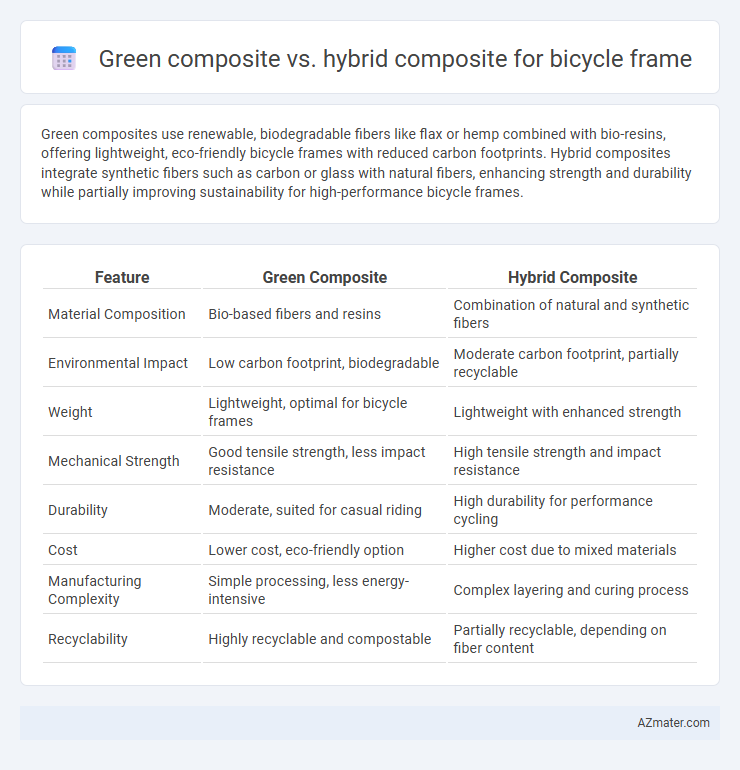Green composites use renewable, biodegradable fibers like flax or hemp combined with bio-resins, offering lightweight, eco-friendly bicycle frames with reduced carbon footprints. Hybrid composites integrate synthetic fibers such as carbon or glass with natural fibers, enhancing strength and durability while partially improving sustainability for high-performance bicycle frames.
Table of Comparison
| Feature | Green Composite | Hybrid Composite |
|---|---|---|
| Material Composition | Bio-based fibers and resins | Combination of natural and synthetic fibers |
| Environmental Impact | Low carbon footprint, biodegradable | Moderate carbon footprint, partially recyclable |
| Weight | Lightweight, optimal for bicycle frames | Lightweight with enhanced strength |
| Mechanical Strength | Good tensile strength, less impact resistance | High tensile strength and impact resistance |
| Durability | Moderate, suited for casual riding | High durability for performance cycling |
| Cost | Lower cost, eco-friendly option | Higher cost due to mixed materials |
| Manufacturing Complexity | Simple processing, less energy-intensive | Complex layering and curing process |
| Recyclability | Highly recyclable and compostable | Partially recyclable, depending on fiber content |
Introduction to Bicycle Frame Materials
Green composites for bicycle frames predominantly use natural fibers like flax or hemp combined with bio-based resins, offering lightweight and eco-friendly alternatives to traditional materials. Hybrid composites integrate synthetic fibers such as carbon or glass with natural fibers to enhance mechanical properties like stiffness and impact resistance while maintaining some sustainability benefits. Selection between green and hybrid composites depends on balancing environmental impact, performance requirements, and cost efficiency in frame manufacturing.
Understanding Green Composites
Green composites for bicycle frames use natural fibers like flax, hemp, or jute combined with bio-based or biodegradable resins, emphasizing sustainability and reduced environmental impact. These composites offer lower carbon footprints and enhanced recyclability compared to traditional synthetic composites but may have limitations in mechanical strength and durability. Understanding green composites involves evaluating fiber-matrix compatibility, moisture absorption behavior, and lifecycle assessment to ensure performance meets cycling demands while promoting eco-friendly manufacturing.
Exploring Hybrid Composites
Hybrid composites for bicycle frames combine natural fibers like flax or hemp with synthetic fibers such as carbon or glass, optimizing strength-to-weight ratio and improving impact resistance compared to solely green composites. This synergy enhances durability, reduces environmental impact, and offers tailored mechanical properties for performance and sustainability. Research indicates hybrid composites can achieve weight savings up to 20% while maintaining stiffness levels essential for high-performance cycling.
Material Composition and Structure Comparison
Green composites for bicycle frames primarily utilize natural fibers such as flax, hemp, or jute embedded in bio-based or biodegradable polymer matrices, promoting environmental sustainability and reduced carbon footprint. Hybrid composites combine natural fibers with synthetic fibers like carbon or glass within epoxy or thermoset resin matrices to achieve enhanced mechanical performance, stiffness, and impact resistance. Structurally, green composites offer lightweight and sufficient strength for low-impact cycling, while hybrid composites provide superior fatigue resistance and higher load-bearing capacity, ideal for high-performance and competitive cycling applications.
Environmental Impact: Green vs Hybrid Composites
Green composites for bicycle frames use natural fibers and biodegradable resins, significantly reducing carbon footprint and waste in production and disposal. Hybrid composites combine synthetic fibers with natural fibers, offering improved mechanical properties but typically result in more complex recycling challenges and higher environmental impact. Evaluating lifecycle assessments reveals green composites achieve superior sustainability metrics through renewable resources and easier end-of-life processing compared to hybrid counterparts.
Mechanical Performance and Durability
Green composite bicycle frames offer superior environmental benefits with moderate mechanical performance and durability, utilizing natural fibers like flax or hemp combined with bio-resins. Hybrid composite frames integrate synthetic fibers such as carbon or glass with natural fibers, significantly enhancing mechanical strength, impact resistance, and long-term durability. Studies show hybrid composites achieve higher tensile strength and fatigue resistance, making them more suitable for demanding cycling conditions.
Weight and Stiffness Analysis
Green composites for bicycle frames utilize natural fibers like flax or hemp, offering lower weight and environmental benefits but often with reduced stiffness compared to hybrid composites. Hybrid composites combine natural fibers with synthetic materials such as carbon or glass fibers, achieving superior stiffness-to-weight ratios essential for performance cycling. Weight and stiffness analysis reveals hybrid composites deliver enhanced rigidity and lighter frames than green composites alone, making them preferred for high-performance bicycle frames requiring both strength and sustainability.
Cost and Manufacturing Considerations
Green composites for bicycle frames typically involve natural fibers like flax or hemp combined with bio-resins, offering lower material costs and reduced environmental impact but requiring specialized processing equipment and longer curing times. Hybrid composites blend synthetic fibers such as carbon or glass with natural fibers, resulting in higher raw material expenses and more complex manufacturing processes due to the need for precise fiber alignment and resin compatibility. Cost efficiency in green composites stems from renewable materials and simpler supply chains, whereas hybrid composites demand advanced technology and skilled labor, impacting overall production timelines and investment.
Adoption in the Bicycle Industry
Green composites, made from renewable natural fibers combined with bio-based resins, are gaining traction in the bicycle industry due to their sustainability and reduced environmental impact. Hybrid composites, which blend traditional carbon fibers with natural fibers, offer a balanced approach by enhancing mechanical performance while partially addressing ecological concerns. Bicycle manufacturers increasingly adopt these materials to meet consumer demand for eco-friendly products without compromising on strength and durability.
Future Trends and Innovations
Green composites for bicycle frames emphasize sustainability by utilizing bio-based fibers and resins, reducing environmental impact while maintaining lightweight properties. Hybrid composites combine natural fibers with high-performance synthetic materials to enhance durability, strength, and fatigue resistance, addressing the demands of advanced riding conditions. Future trends include the integration of nanomaterials and smart sensors within these composites to improve performance monitoring and structural health, promoting innovation in eco-friendly and high-tech bicycle designs.

Infographic: Green composite vs Hybrid composite for Bicycle frame
 azmater.com
azmater.com